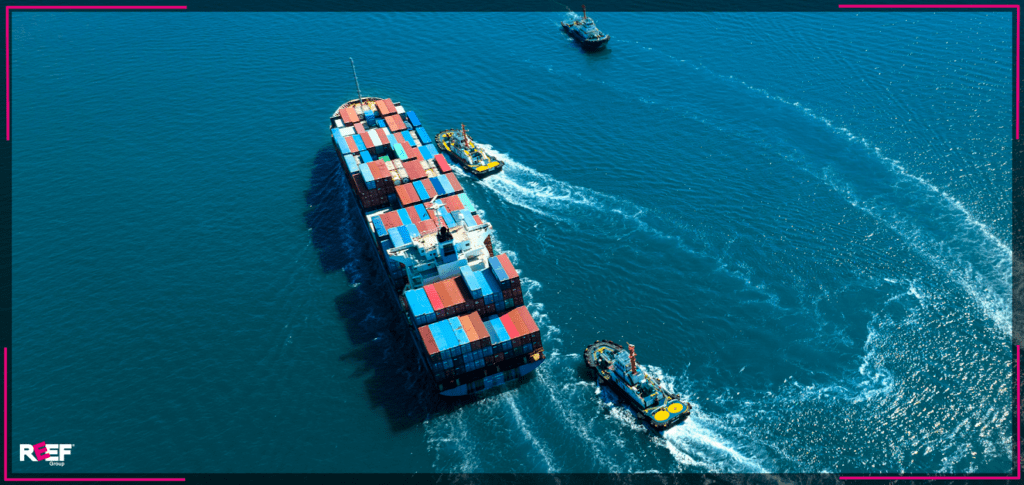Adverse Weather Conditions and Other Challenges in Container Handling

Preparing Machinery Before Transport? Here’s What You Need to Know
June 10, 2024
Transporting Prefabricated Buildings Why Low Loaders Are the Ultimate Solution
August 19, 2024

As a reputable freight transport service provider, Reef Group takes the subject of disrupted supply chains very seriously. We see it as our responsibility to stay on top of the latest analysis and reporting methods that help us to react quickly to knock-on events and mitigate the adverse effects of extreme weather conditions. This article examines the crucial role each phase of the chain plays in its continuing flow and how adverse weather conditions threaten operations if they are not accurately predicted and handled.
The Importance and Complexity of Seamless Maritime Logistics
Maritime logistics are critical in fast, safe, and efficient container handling operations and the smooth, continuous flow of cargo. We can break the logistical side of things into several vital operations, namely:
Quayside:
Quay cranes require skilled operators to lift containers off ships and transfer them, often to automated guided vehicles (AGVs).
Landside:
Once the containers are delivered to the landside handling area by the AGVs, several operations are involved before they can move on. These include:
- Stacking
- Temporary storage
- Preparation for onward transportation
Transhipment:
Transhipment describes transferring containers from one ship directly to another at the quayside. This common practice allows cargo to continue onward to its final destination if a direct route is unavailable.
Each step of the process must function flawlessly to avoid holding up the others, and they require immense, highly accurate logistical efforts to remain in sync.
How Does Adverse Weather Affect Container Handling Operations?
Container operations are integral to sustaining free-flowing global supply chains; without them, all international trade would come to a grinding halt. Mitigating any challenges and issues that arise is non-negotiable if seamless operations are to be maintained, and one of the most significant challenges they face is adverse, unpredictable weather.
- High winds
High winds are among the most common and severe challenges these locations face. They put the tall quayside cranes at risk and generate wild, unpredictable waves and swells that occasionally pitch containers over the side before they can be safely removed. This is expensive and disruptive to the company’s supply chain and reputation and extremely dangerous for those tasked with working close to the containers.
- Fog and heavy rainfall
When visibility is reduced by the appearance of thick fog or extreme rainfall, the automated elements of the process remain largely unaffected. However, it is impossible for crane operators at the quayside to safely load and remove containers they cannot see. Even with impressive technological advancements and the placement of guiding devices and cameras, the task is exponentially more difficult and dangerous when visibility drops and subsequent delays are inevitable.
The Increase in Extreme Weather
As global temperatures continue to rise inexorably, so do ocean and sea levels. We can only conclude that the incidents of extreme, severe weather conditions are set to increase, and climate change will likely impose billions of dollars in additional shipping and associated costs each year. Those costs are predicted to double by 2050, and there is evidence to suggest that those predictions actually fall far short of the eventual outcome.
The Sudden Nature of Extreme Weather
Predicting sudden extreme weather changes and assessing their potential impact on shipping logistics is exceptionally complex and affected by various changeable factors. Despite incredible advancements in modern weather monitoring and forecasting methods, it remains impossible to predict the behaviour of random, atypical weather systems with 100% accuracy. The challenge for shipping operators all over the globe is significant, and the sudden appearance of violent storms and other extreme weather events can wreak havoc on scheduling, loading and unloading logistics, and, inevitably, the wider supply chain.
Although the challenges are immense and look set to increase with time, accurate weather prediction remains a powerful tool in the arsenal of shipping and logistics companies. Using the latest technological advancements, they can implement alternative, adaptive strategies designed to minimise the impact of dramatic weather shifts.
What Are the Common Challenges in Container Handling?
The challenges of handling shipping containers are many and vary from one location to the next.
- Infrastructure limitations
Demand for container shipping has surged, putting extra strain on existing infrastructure. Only a concerted effort to expand capabilities and reinforce weak links can begin to address the issue. Automated cargo handling systems are starting to positively affect the situation as they enhance efficiency and facilitate a more consistent, predictable throughput.
Many less adequately equipped facilities lack the essential infrastructure to handle even minor delays, and their limitations can easily reverberate throughout the entire supply chain. Along with the need for upgrades and modernisation, they struggle with the onset of rising sea levels, which push up operational costs, risking further delays and damage to existing structures.
Other significant challenges that affect the industry include:
- Supply chain visibility
- Container security
- Capacity management
Mitigating Environmental Impact
Although the shipping industry is among the most seriously affected by increases in adverse weather conditions, it would be remiss not to mention its role in the problem. The environmental damage caused by industrial shipping has significantly exacerbated the situation, and strategies must be employed to reduce its overall impact. Innovations aimed at enhancing sustainability and limiting the environmental harm caused include:
- Onshore power supplies
To reduce the need for visiting ships to run their engines while docked, many ports are now opting to provide onshore power systems that connect them to the wider electrical grid, reducing air pollution and carbon emissions.
- Environmentally responsible fuels and renewable energy
Alternative fuels like biofuels, liquefied natural gas, and hydrogen are in development for modern ships. Some ports have also taken to using their natural environment to aid in the battle to reduce emissions, such as installing solar panels and wind turbines to reduce fossil fuel reliance.
Some other critical movements towards cleaner, more sustainable shipping logistics include:
- Reusing and recycling materials
- Effective, responsible waste management
Technological Solutions and Expert Advice
Maritime logistics will likely never be able to rely solely on automation and technology to survive and thrive. However, increasing evidence suggests that a combination of expert advice and advanced technological solutions may forge a path forward.
Some significant ways technology can assist the industry to cope with its many challenges include:
- Instant weather monitoring and reporting
- Algorithms for route and delivery schedule optimisation
- Improved communication, both locally and globally
- Increased driver and machine operator safety
- Reduced transportation costs
- Preparedness and the ability to respond and adapt quickly
Conclusion
While the challenges facing the global supply chain are clear and pressing, there is some cause for optimism. Advancements in technology all along the chain are taking some of the excess strain out of the equation by handling time-consuming, mundane tasks that, nevertheless, require focus and accuracy.
The industry can no longer afford to pretend that increased temperatures and the chaos they will surely bring are not potentially devastating. However, with a strong emphasis on collaboration and continuously adapting to each new development using technology to relieve the pressure, there is reason to believe that the challenges can be met successfully.


